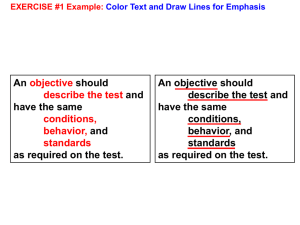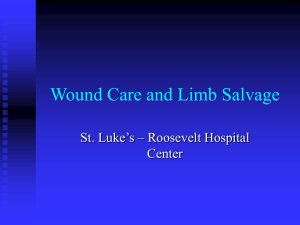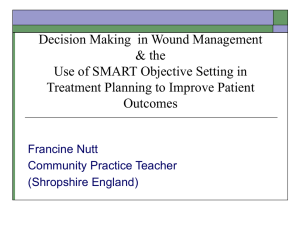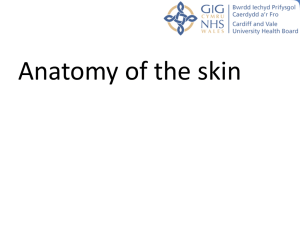Closure of skin wounds
advertisement
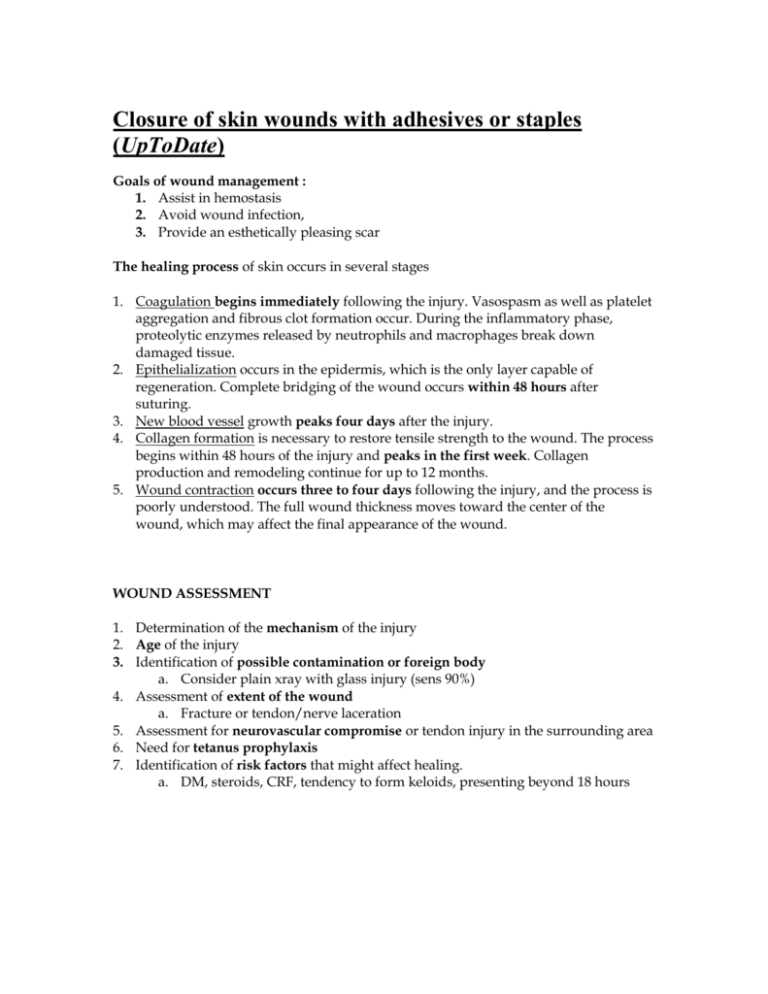
Closure of skin wounds with adhesives or staples (UpToDate) Goals of wound management : 1. Assist in hemostasis 2. Avoid wound infection, 3. Provide an esthetically pleasing scar The healing process of skin occurs in several stages 1. Coagulation begins immediately following the injury. Vasospasm as well as platelet aggregation and fibrous clot formation occur. During the inflammatory phase, proteolytic enzymes released by neutrophils and macrophages break down damaged tissue. 2. Epithelialization occurs in the epidermis, which is the only layer capable of regeneration. Complete bridging of the wound occurs within 48 hours after suturing. 3. New blood vessel growth peaks four days after the injury. 4. Collagen formation is necessary to restore tensile strength to the wound. The process begins within 48 hours of the injury and peaks in the first week. Collagen production and remodeling continue for up to 12 months. 5. Wound contraction occurs three to four days following the injury, and the process is poorly understood. The full wound thickness moves toward the center of the wound, which may affect the final appearance of the wound. WOUND ASSESSMENT 1. Determination of the mechanism of the injury 2. Age of the injury 3. Identification of possible contamination or foreign body a. Consider plain xray with glass injury (sens 90%) 4. Assessment of extent of the wound a. Fracture or tendon/nerve laceration 5. Assessment for neurovascular compromise or tendon injury in the surrounding area 6. Need for tetanus prophylaxis 7. Identification of risk factors that might affect healing. a. DM, steroids, CRF, tendency to form keloids, presenting beyond 18 hours WOUND PREPARATION 1. Wound irrigation a. Saline or tap water, splash guard b. Can use dilute betadine (1:10 Betadine/saline) for contaminated wounds. 2. Foreign body removal a. Remove splinters, glass, metal 3. Necrotic tissue debridement Indications for secondary closure (ie, by granulation) include: 1. 2. 3. 4. 5. Deep stab or puncture wounds that cannot be adequately irrigated Contaminated wounds Small noncosmetic animal bites Abscess cavities Presentation after a significant delay (>18h, or>24h head and neck) Types of closure 1. Sutures a. Simple interrupted commonly used 2. Tissue adhesives a. cyanoacrylate polymers Dermabond (Ethicon). 3. Staples A. Tissue adhesives http://www.aafp.org/afp/20000301/1383.html http://www.uptodateonline.com/utd/content/topic.do?topicKey=ped_proc/9347&select edTitle=1~13&source=search_result Physiology — Cyanoacrylate tissue adhesives are liquid monomers that undergo an exothermic reaction on exposure to moisture (eg, on the skin surface), changing to polymers that form a strong tissue bond. When applied to a laceration, the polymer binds the wound edges together to allow normal healing of the underlying tissue. Maximum bonding strength is achieved within 2.5 minutes of application DERMABOND is 2 Octyl cyanoacrylate – low toxicity, has addition of plasticizers which provide increased flexibility. Replacement for 5-0 or smaller sutures Advantages — over sutures and staples: 1. 2. 3. 4. 5. 6. 7. Less painful application, and sometimes no need for local anesthetic injection More rapid application and repair time Cosmetically similar results at 12 months post-repair Waterproof barrier, no need to keep areas dry; bandages usually not required Antimicrobial properties Better acceptance by patients No need for suture or staple removal or follow-up Efficacy — Several randomized clinical trials in both children and adults have found that there is no significant difference in outcomes when either lacerations or surgical incisions are repaired with tissue adhesive versus standard wound closure (eg, sutures, adhesive strips) INDICATIONS- good wound approximation with no wound tension. The ideal laceration is clean and linear. CONTRAINDICATIONS1. Complex stellate lesions or crush injuries should not be closed with tissue adhesives since good wound approximation is difficult to achieve. 2. Hands, feet, or joints, unless immobilized 3. Oral mucosa or other mucosal surfaces 4. Areas of high moisture such as the axillae and perineum. 5. hairline or vermilion border of the lip require more precision 6. Puncture wounds and most bites- increased risk of infection 7. Patients with diabetes mellitus, chronic vascular disease, peripheral vascular disease, decubitus ulcers, prolonged steroid use, history of keloids, bleeding diathesis, allergy to adhesives TECHNIQUE OF APPLICATION http://www.dermabond.com/bgdisplay.jhtml?itemname=how-it-works 1. 2. 3. 4. 5. 6. 7. 8. 9. 10. 11. Wound prep Cleanse wound, placement of subcutaneous sutures if necessary Evert or appose edges using the fingers or tissue forceps. Achieve hemostasis because blood interferes with adherence of the adhesive to the skin. Remove any tissue or hair that extrudes through or overlies the wound edges Crack vial, squeeze to saturate the foam tip, wipe gently over the wound edges in a single motion, spreading a thin film Don’t press into the wound, (may cause a foreign body reaction that prevents normal wound healing) .If this occurs, wipe off, using petroleum jelly or antibiotic ointment to loosen the polymer. allow to dry for 30 to 40 seconds while continuing to hold the wound edges together to allow complete polymerization repeat three to four times in an oval pattern around the wound Wound closure strength is enhanced by extending the application 5 to 10 mm beyond the margin of the incision Don’t touch the wound for about 5 minutes. AFTERCARE 1. 2. 3. 4. 5. 6. No bandage needed No ointment May shower ;avoid long soaks No scrubbing or picking for 7-10 days Peels in 5-10 days or can use petroleum jelly to remove No follow up needed COMPLICATIONS Leakage, sticks to gloves/instruments If gets in the eye or eyelids generous amounts of ophthalmic antibiotic ointment should be placed on the eyelid to break down the adhesive and an ophthalmologist should be consulted COST- $24/vial ($5 for suture pack), but similar in terms of time, f/u appt, suture removal kit B. Staples Pros (over sutures) Cons 1. More rapid 2. Avoid needle stick risk 3. Good wound eversion 1. More painful removal 2. Higher risk of scarring 3. Less precise- avoid in face/neck/hands/feet 4. CT- artifact; MRI -avulsion Ideal wound- linear with straight, sharp edges PROCEDURE 1. Wound assessment 2. Anesthesia- regional or local 3. Evert wound with forceps or by pinching the skin with the thumb and index finger. 4. Place stapler firmly on the surface but without indenting the skin; squeeze the handle gently to eject the staple into the tissue. Release by pulling the wrist back. 5. Apply antibiotic ointment (eg bacitracin), dressing for 24-48hours Removal of staples (same as sutures) 1. Neck - 3 to 4 days 2. Face and scalp - 5 days 3. Eyelids - 3 days 4. Trunk and upper extremities - 7 days 5. Lower extremities - 8 to 10 days Wound management and tetanus prophylaxis Previous doses of adsorbed tetanus toxoid* Clean and minor wound All other wounds Tetanus toxoid TIG Tetanus toxoid TIG <3 or unknown Yes§ No Yes§ Yes Only if last dose given 10 years ago No Only if last dose given 5 years ago No 3





